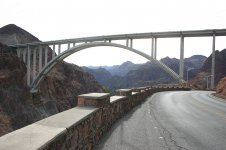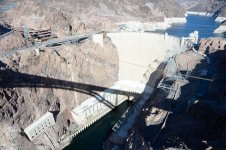For the second part of our road trip, my Wife, the Fairest Sandra the Red, and I preran the first three legs of the 2014 National Corvette Caravan in reverse order, from Amarillo, Texas to Barstow, California. This pre run trip, the fourth one I’ve done as Section Captain for southern California, southern Nevada and southwestern Utah, was to visit several of our overnight stops and meet with the folks in those places who will help us stage events.
In Amarillo, we met with Holt Davis, Section Captain for Arizona and New Mexico, and Larry Teague of the Amarillo Area Corvette Club. The parties discussed what type of event will be staged in Amarillo for the two Section's visit on Sunday night, 24 Aug. 2014. The original plan was a group dinner but finding an air conditioned venue large enough proved difficult so, tentatively, the group dinner has been moved to the previous stop, Albuquerque, New Mexico.
The next morning, after a quick photo op at Cadillac Ranch just west of Amarillo,
 The Fairest Sandra the
The Fairest Sandra the
Red with the BB2 at
Cadillac Ranch
it was on to Adrian TX on I-40, 22 miles east of the New Mexico line. Adrian was the middle of old Route 66–1193 miles from L.A. and 1193 miles from Chicago. The famed Mid-Point Cafe has been there since 1928. The Mid-Point slogan is, "When you're here, you're halfway there." On the 2009 Caravan, on the morning of Day Three, we used the Mid-Point Cafe for our departure event. It was, also, where the SoCal/SoNev Section joined with Captain Tuna Dobbins' Oklahoma/Texas Panhandle Section. Three hundred Corvettes staged in three lines on the street in front of the Mid-Point was quite a sight. On the 2014 trip, we'll be in Adrian late afternoon on Day Three. My idea is to stop at the Mid-Point for the Cafe's famed "Ugly Crust" pie along with shopping at Fran Houser's Sunflower Station country-style gift shop which is next door.
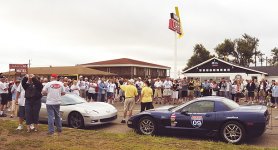 Caravaners at the Mid-Point
Caravaners at the Mid-Point
Cafe, 31 Aug. 2009.
We met with Dennis Purschwitz, owner of the Mid-Point Cafe over breakfast and discussed the logistics of the Caravan's stop at the Mid-Point with 350 Corvettes and 700 folks hungry for an afternoon snack and a photo op at the signage marking the mid-point of old US 66. We also stopped in at Sunflower Station and spoke to Fran Houser, who owned the Mid-Point from 1990-2012. When John Lassiter was developing the movie "Cars" Fran was the inspiration for "Flo" in the movie. Houser decided to sell the cafe and get into the more relaxed crafts store business. We chatted about our previous visits to the Mid-Point when she owned it and told her to, just prior to our visit next year, stock up.
From there, PreRun4 moved on to exit on I-40 where we turned north on US84 and what was the pre-1937 alignment of Route 66. We did this part of old 66 on PreRun2 in 2011, but the scenery is so beautiful, we wanted to drive it again.
That evening we were in Albuquerque to meet with Capt. Davis and her top deputy, Sherry Maples, along with the group sales staff at the Crowne Plaza hotel. That meeting resulted in a contract with the "CP" and its sister hotel next door, the Fairfield Inn. All the Caravaners will be in those two properties. The two Organizing Teams, also, used this opportunity to discuss a joint event, likely a catered New Mexican style dinner at one of the Chevrolet dealers in Albuquerque.
The final stop for PreRun4 was Williams, Arizona. Like all the other overnight cities for the 2014 Caravan, Williams will be a new destination. In October of 1984, Williams was the last city bypassed by Interstate 40. Route 66 was decommissioned the following year. Williams is a quaint, friendly town, known for it's western atmosphere and for being the gateway to the Grand Canyon. Over dinner at the Red Raven on Old 66 we discussed the Caravan's visit to Williams with Mayor, John Moore, President of the Chamber of Commerce, Gioia Goodrum.
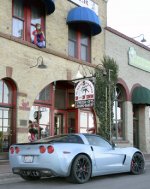 The Blue Bullet 2 at
The Blue Bullet 2 at
the famed Red Garter
Bed & Breakfast in Williams
The Caravan's events will be a Show/Shine Corvette Show on Route 66 in the center of town on a Friday night. The Show will last about 2 1/2 hours and during that time Caravaners will have the opportunity to have dinner in one of Williams many eating establishments which range from fast food to, Mexican, to Italian, to American and to a couple of fine steak houses.
On a Friday night in late Summer, Williams will be rockin' and there are all sorts of bars and clubs to share a glass of beer or wine and take in live music. There are a couple of car-themed spots, "Cruisers Route 66 Cafe" and "Twisters:. Expectedly are several western-themed eateries as a small theme park called "Wild West Junction" which has great food. Then there are a number of crafts, novelty, gift and clothing shops. Notable are "Addicted to Route 66" where you can find virtually any Route 66 item in existence and "Thunder Eagle Native Art" perhaps the finest Native American jeweler in the country. In short, Caravaners can count on a unique experience in Williams, Arizona.
The next morning, we stopped at Wild West Junction and had breakfast at the Branding Iron Restaurant. After a tasty meal we put some gas in the Blue Bullet 2 then headed west on I-40. We decided to do short side trip up to Seligman and see if we could catch John Delgadillo who runs the famed Snow Cap Drive-In just as he's opening up. A fixture on old 66 in northwestern Arizona, the Snow-Cap was started 60 years ago by John’s Dad, Juan. The Snow Cap, famed for its whacky decoration, fun-loving :Sillystaff and wonderfully-chilly ice cream cones on hot days, has been a Caravan stop since the first event in 1994.
We got off 40 at exit 139 then drove old 66–marked on a lot of maps as “Crookton Rd”–westbound to Seligman. This stretch of old 66 is sparsely-traveled and in very good condition so we set the cruise control for 100 mph–that’s what you’re supposed to do on roads like that, right? Needless to say, we were in Seligman in no time. In fact, we were too early. The Snow-Cap wasn’t open and wouldn’t be for several hours, so we got back on 40 and continued driving home.
Gas in Barstow, then SR58 over to Kramer Junction and on to Mojave. Between my Sis living in Henderson, Nevada and Caravan pre runs, I drive this route all the time and, when I go by the southeast corner of Mojave Airport, I always see this big unmarked hanger and a brilliant blue and white, but otherwise unmarked, Boeing 747 sitting in front–somebody’s expensive private transportation, I suppose. I’ve wondered who owns it and if they’ll give me and 50 of my friends a ride. Heck, we’ll bring our own beer.

Down the 14 freeway to SR138 and a trophy run across the western Antelope Valley to I-5 south. South to Magic Mountain then right on SR126 to US101 north and Goleta. Home-sweet-home after nearly two weeks on the road.

Good thing, as I was out of clean underwear. Ok. I know–too much information.
The 3800 mile road trip ended and, on looking at my vehicle maintenance log, it was time to change the oil filter, so I screwed on a fresh UPF48R. Then I ran the car back down to Graham Chevrolet to have the HVAC checked out. They had the car for two days. No codes were set in the HVAC controller and the A/C worked fine during their road tests Nevertheless, for the system to have quit while we were down in Texas, there’s a problem somewhere. I’m just going to have to keep driving the car until it happens again.
One problem was once-again obvious on this trip and that’s the amount of interior heat which comes off the center console and the sides of the tunnel in this car. I talked about this in a post #129 when I discussed installing a “Thermal ABS” tunnel close-out plate. Putting that on made the situation better, but still, on long trips on hot days, too much heat comes off that console.
My next try at reducing the amount of heat radiated by the tunnel was to install a 180° thermostat. For more than a year after I bought the car, I waited for some manufacturer to come to market with a 180. Rumors I read on other forum sites was that there were no 180s for 09-13 LS7s–since the stock ‘stat was a 186, there was little incentive for a thermostat maker to sell a 180. Well–about two weeks ago I was wandering around at
Rockauto.com and found a Stant 180° unit listed for LS7s. I ordered it and, typical of RockAuto, it arrived quickly. Sure enough, while it looks a little different, it’s the right size and has the correct bypass spring. I tested it and a stock ACDelco thermostat and true to their advertised opening points, the Stant from Rockauto started opening at 178-180°F and the ACD started opening at 186-188°. The Stant was full open at 200-202,° but the ACD was not full open at 210° which was as hot as the water in the pot would get. The bottom and sides of the pot were at 212° so the water was boiling.
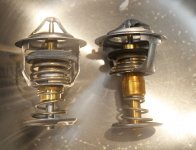 'Stats in the pot on the stove
'Stats in the pot on the stove
at 205°F. The Delco, at left, is
partially open. The Stant from
Rockauto.com, at right,
is full-open
So far, the thermostat seems to make a contribution to reducing temperature. At highway speed in sixth gear, my engine coolant temperature went from about 199-200° down to 194° or so. Because at low rpm, the LS7s water pump turns quite slowly, if I downshift to fifth, the rpm goes up and the coolant temperature drops to 184°F.
I still have more work to do on this heat problem. I've said before that the ‘12s and ‘13s have two sets of cats. The rear set is right under the tunnel about where your thighs are. Cats are big heat sinks, that is they store and radiator lots of heat. I’ve thought about pulling the exhaust, cutting the rear set of cats out of the system, then wrapping the exhaust behind the remaining set of cats with Design Engineering Exhaust Wrap and, finally, adding some more thermal insulation from Design Engineering to the inside of the tunnel.
What would really be cool is to find the source for the “Aerogel” GM is using in the C7 tunnel for thermal insulation and try some of that stuff.
All I need is the time to do it.







 ad
ad
ad


 As "Maverick" McCravy told us, "We wanted to make more of an impact for our wounded Veterans and to let them know how much everyone cared and supported them. This time we raised $32,500 for the WWP. It did not stop there. We knew that the 2011 event would be on the 10th anniversary of September 11 so we raffled a Camaro, changed it to a 2-day event, added a Saturday night dance and a live auction. The event was another huge success. We raised $50,000."
As "Maverick" McCravy told us, "We wanted to make more of an impact for our wounded Veterans and to let them know how much everyone cared and supported them. This time we raised $32,500 for the WWP. It did not stop there. We knew that the 2011 event would be on the 10th anniversary of September 11 so we raffled a Camaro, changed it to a 2-day event, added a Saturday night dance and a live auction. The event was another huge success. We raised $50,000."

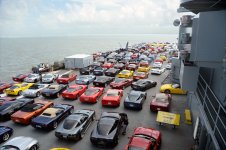




 Good thing, as I was out of clean underwear. Ok. I know–too much information.
Good thing, as I was out of clean underwear. Ok. I know–too much information.



